Plankton

Plankton are any drifting organism that inhabits the water column of oceans, seas, and bodies of fresh water. They are widely considered to be some of the most important organisms on Earth, due to the food supply they provide to most aquatic life.
Definitions
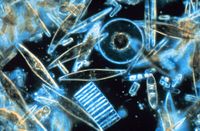
The name plankton is derived from the Greek word πλανκτος ("planktos"), meaning "wanderer" or "drifter"[1]. While some forms of plankton are capable of independent movement and can swim up to several hundreds of meters vertically in a single day (a behavior called diel vertical migration), their horizontal position is primarily determined by currents in the body of water they inhabit. By definition, organisms classified as "plankton" are unable to resist ocean currents. This is in contrast to nekton organisms that can swim against the ambient flow of the water environment and control their position (e.g. squid, fish, krill and marine mammals).
Within the plankton itself, holoplankton are those organisms that spend their entire life cycle as part of the plankton (e.g. most algae, copepods, salps, and jellyfish). By contrast, meroplankton are those organisms that are only planktonic for part of their lives (usually the larval stage), and then graduate to either the nekton or a benthic (sea floor) existence. Examples of meroplankton include the larvae of sea urchins, starfish, crustaceans, marine worms, and most fish.
Plankton abundance and distribution are strongly dependent on factors such as ambient nutrients concentrations, the physical state of the water column, and the abundance of other plankton.
The study of plankton is termed planktology. Individual plankton are referred to as plankters.
Functional groups
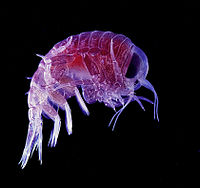
Plankton are primarily divided into broad functional (or trophic level) groups:
- Phytoplankton (from Greek phyton, or plant), autotrophic prokaryotic or eukaryotic algae that live near the water surface where there is sufficient light to support photosynthesis. Among the more important groups are the diatoms, cyanobacteria and dinoflagellates.
- Zooplankton (from Greek zoon, or animal), small protozoans or metazoans (e.g. crustaceans and other animals) that feed on other plankton and telonemia. Some of the eggs and larvae of larger animals, such as fish, crustaceans, and annelids, are included here.
- Bacterioplankton, bacteria and archaea, which play an important role in remineralising organic material down the water column (note that the prokaryotic phytoplankton are also bacterioplankton).
This scheme divides the plankton community into broad producer, consumer and recycler groups. In reality, the trophic level of some plankton is not straightforward. For example, although most dinoflagellates are either photosynthetic producers or heterotrophic consumers, many species are mixotrophic depending upon their circumstances.
Size groups
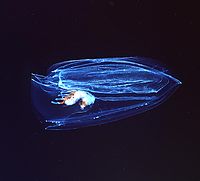
Plankton are also often described in terms of size[2]. Usually the following divisions are used:
| Group | Size range (ESD) | Major organisms | |
| Megaplankton | 2×10-1→2×100 m | (20-200 cm) | metazoans ; e.g. jellyfish |
| Macroplankton | 2×10-2→2×10-1 m | (2-20 cm) | metazoans ; e.g. pteropods |
| Mesoplankton | 2×10-4→2×10-2 m | (0.2mm-2 cm) | metazoans ; e.g. copepods |
| Microplankton | 2×10-5→2×10-4 m | (20-200 µm) | large eukaryotic protists; juvenile/small metazoans |
| Nanoplankton | 2×10-6→2×10-5 m | (2-20 µm) | small eukaryotic protists |
| Picoplankton | 2×10-7→2×10-6 m | (0.2-2 µm) | small eukaryotic protists; bacteria |
| Femtoplankton | < 2×10-7 m | (< 0.2 µm) | marine viruses |
However, some of these terms may be used with very different boundaries, especially on the larger end of the scale. The existence and importance of nano- and even smaller plankton was only discovered during the 1980s, but they are thought to make up the largest proportion of all plankton in number and diversity.
Distribution
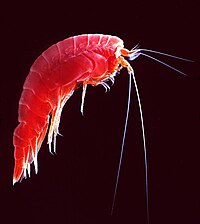
Plankton are found throughout the oceans, seas and lakes of Earth. However, the local abundance of plankton varies horizontally, vertically and seasonally. The primary source of this variability is the availability of light. All plankton ecosystems are driven by the input of solar energy (but see chemosynthesis), and this confines primary production to surface waters, and to geographical regions and seasons when light is abundant.
A secondary source of variability is that of nutrient availability. Although large areas of the tropical and sub-tropical oceans have abundant light, they experience relatively low primary production because of the poor availability of nutrients such as nitrate, phosphate and silicate. This is a product of large-scale ocean circulation and stratification of the water column. In such regions, primary production, still usually occurs at greater depth, although at a reduced level (because of reduced light).
Despite significant concentrations of macronutrients, some regions of the ocean are unproductive (so-called HNLC regions)[3]. Field studies have found that the mineral micronutrient iron is deficient in these regions, and that adding it can lead to the formation of blooms of many (though not all) kinds of phytoplankton[4]. Iron primarily reaches the ocean through the deposition of atmospheric dust on the sea surface. Paradoxically, oceanic areas adjacent to unproductive, arid regions of continents thus typically have abundant phytoplankton (e.g., the western Atlantic Ocean, where trade winds bring dust from the Sahara Desert in north Africa). It has been suggested that large-scale "seeding" of the world's oceans with iron could generate blooms of phytoplankton large enough to draw down enough carbon dioxide out of the atmosphere to offset its anthropogenic emissions (responsible for global warming), although other researchers have disputed the scale of this effect[5].
While plankton are found in the greatest abundance in surface waters, they occur throughout the water column. At depths where no primary production occurs, zooplankton and bacterioplankton instead make use of organic material sinking from the more productive surface waters above. This flux of sinking material can be especially high following the termination of spring blooms.
Biogeochemical significance
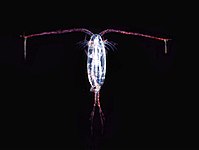
Aside from representing the bottom few levels of a food chain that leads up to commercially important fisheries, plankton ecosystems play a role in the biogeochemical cycles of many important elements. Of particular contemporary significance is their role in the ocean's carbon cycle.
As stated, phytoplankton fix carbon in sunlit surface waters via photosynthesis. Through (primarily) zooplankton grazing, this carbon enters the planktonic foodweb, where it is either respired to provide metabolic energy, or accumulates as biomass or detritus. As living or dead organic material is typically more dense than seawater it tends to sink, and in open ocean ecosystems away from the coasts this leads to the transport of carbon from surface waters to the deep. This process is known as the biological pump, and is one of the reasons that the oceans constitute the largest (active) pool of carbon on Earth.
Some researchers have even proposed that it might be possible to increase the ocean's uptake of carbon dioxide generated through human activities by increasing the production of plankton through fertilization, primarily with the micronutrient iron. However, it is debatable whether this technique is practical at a large scale, and some researchers have drawn attention to possible drawbacks such as ocean anoxia and resultant methanogenesis (caused by the excess production remineralising at depth)[6] .
Importance to fish
Zooplankton are initially the sole prey item for almost all fish larvae as they use up their yolk sacs and switch to external feeding for nutrition. Fish species rely on the density and distribution of zooplankton to coincide with first-feeding larvae for good survival of larvae, which can otherwise starve. Natural factors (i.e. variations in oceanic currents) and man-made factors (i.e. dams on rivers) can strongly affect zooplankton density and distribution, which can in turn strongly affect the larval survival, and therefore breeding success and stock strength, of fish species.
Popular culture
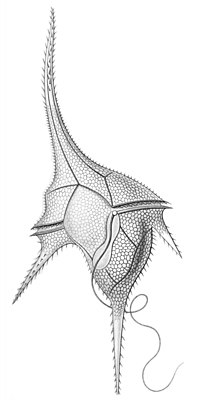
- In the animated television series SpongeBob SquarePants, Sheldon J. Plankton is the name of one of the primary antagonists SpongeBob faces. His relationship to plankton is manifested in his size, as he is much smaller than the other characters, and also by his single, copepod-like, eye.
- In an episode of the animated television series The Simpsons, the family chooses to go shopping at a 33-cent discount store which offers a variety of strange foods. Homer purchases and eats expired canned plankton, and consequently falls ill as a result of red tide poisoning.
- The science fiction novels Timescape by Gregory Benford, and The Secret Of Life by Paul McAuley both invoke environmental disasters caused by changes in the behaviour of plankton.
- In Electroplankton, a videogame for the Nintendo DS handheld console, the player uses a plankton-themed interface to create music.
- In the movie Soylent Green, the Soylent Corporation claims that soylent green is made of plankton. While the ending suggests that it may have once been true, and it may still be an ingredient, it certainly isn't the main ingredient, as revealed by the movie's twist ending.
References

- ^ {{cite book Why this wasn't originally included I don't know: there are two types of plankton: phtoplankton are producers, but not plants, and zooplankton eat phytoplankton, but are not animals. >:| | last = Thurman | first = H. V. | year = 1997 | title = Introductory Oceanography | publisher = Prentice Hall College | location = New Jersey, USA | ISBN = 0132620723 }}
- ^ Omori, M. (1992). Methods in Marine Zooplankton Ecology. Malabar, USA: Krieger Publishing Company.
{{cite book}}: Unknown parameter|coauthors=ignored (|author=suggested) (help) - ^ Martin, J. H. and Fitzwater, S. E. (1988) Iron-deficiency limits phytoplankton growth in the Northeast Pacific Subarctic. Nature 331, 341-343.
- ^ Boyd, P.W.; et al. (2000). "A mesoscale pytoplankton bloom in the polar Southern Ocean stimulated by fertilization". Nature. 407: 695–702.
{{cite journal}}: Explicit use of et al. in:|first=(help) - ^ Aumont, O. and Bopp, L. (2006) Globalizing results from ocean in situ iron fertilization studies Global Biogeochemical Cycles 20 : doi:10.1029/2005GB002591.
- ^ Chisholm, S.W.; et al. (2001). "Dis-crediting ocean fertilization". Science. 294: 309–310.
{{cite journal}}: Explicit use of et al. in:|first=(help)
See also
External links
- Plankton*Net, taxonomic database of images of plankton species
- Plankton*Net, taxonomic database of images of plankton species
- Save the Plankton! (Stop the Whales!) by Michael Dare
